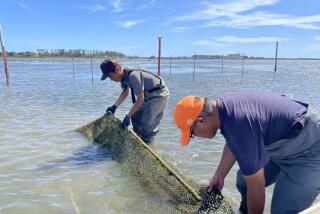Tearing Down the ‘Curtain of Death’ : In a most welcome announcement, Tokyo says it will end horrific drift-net practice
- Share via
Drift nets are called “curtains of death” for a good reason. They have been used by fishermen to blanket the seas, killing everything unlucky enough to cross their path--including dolphins and sea birds. Thus Japan’s historic agreement to ban the use of high-seas drift nets paves the way for a long-overdue international moratorium on a practice that has caused marine devastation. The world community must take advantage of the renewed momentum created by Japan’s decision to conclude a U.N. agreement that will carry the force of international law.
Under terms set by Tokyo’s agreement, Japanese fishing boats will phase out half of the drift nets by next June. The fishing fleet of Japan, the world’s biggest drift-netting nation, will cease using the nets by the end of 1992. The United Nations hopes to pass a worldwide moratorium by the end of this year that would also take effect next June.
The sad irony is that a U.N. agency pioneered drift-net technology during the early 1960s to help then-struggling Asian nations increase their fishing yields. The nets were useful because fishermen could leave them in the water for days at a time, allowing each boat to increase its catch from hundreds of pounds of fish to thousands of pounds.
But although drift nets have increased yields, they have also indiscriminately killed millions of sea creatures. These “curtains of death” hang for depths of up to 60 feet and can stretch for as much as 30 miles.
One-tenth of drift-net vessels killed 1,758 whales and dolphins, 30,464 sea birds, 81,956 blue sharks and more than 3 million other fish not intended to be caught. Drift-net use in the Northern Pacific has led to a substantial reduction in the legitimate catch of mature salmon and trout. Overfishing, like timber clearcutting, upsets the balance of nature and over the long run undermines the sea’s ability to replenish itself for future harvests. While Japan’s action is encouraging, the United States should not lose sight of the ultimate goal. Washington should continue to push the U.N. moratorium and pressure South Korea--the last country with a substantial drift-net fleet--to end the environmentally unconscionable practice.
More to Read
Sign up for Essential California
The most important California stories and recommendations in your inbox every morning.
You may occasionally receive promotional content from the Los Angeles Times.












